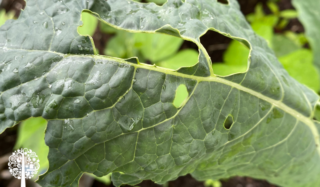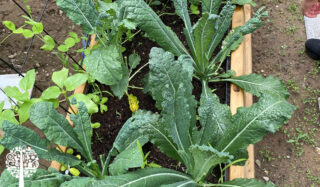Before the cabbage worm moved into my garden, my kale had never looked so good. Perfect, dark green leaves stood tall in the raised beds, impressing friends and family alike. People actually commented on how amazing the kale looked! Beyond being a conversation starter, It tasted incredible; just a few nights before discovering the wretched worm devouring my crop, we enjoyed it in white bean quesadillas. But things went downhill from there.

Just Like That…
It all happened so quickly. One morning, I was out in the garden, backfilling potato buckets and securing plants to trellises, when my husband asked me what was lurking around the kale.
Completely panicked, I scissor-jumped two other raised beds to investigate (you got me; scissor-jumping is not something I’m physically capable of doing, but I did get there fast).
The Damage
It was a sad scene over there in the kale section. My once gorgeous leaves were riddled with holes; some were completely eaten, with only the rib standing. They were skeletons of themselves, really.

The plants were covered in poop, and when I looked closely, I found many green caterpillars camouflaged on the center rib of the leaves.
I grabbed my copy of Susan Mulvihill’s The Vegetable Garden Pest Handbook and learned I had a cabbage worm infestation.
Cabbage Worms
According to the book, cabbage worms (Pieris rapae) are the larvae of imported cabbage white butterflies. The female butterflies lay their yellowish eggs on the underside of the leaves; the resulting caterpillars are about 1.5” long, pale green with fuzzy hairs and a yellow line running down their backs.

They’re common in most veggie gardens and love cabbage family crops like arugula, broccoli, Brussels sprouts, cauliflower, kohlrabi, radishes, rutabagas, and turnips.
Once the caterpillars hatch, they quickly eat whatever they can. In a matter of days, my kale beds looked like a page in Eric Carl’s The Very Hungry Caterpillar.
Natural Predators
Many natural predators will help control cabbage worms, including damsel bugs, hoverflies, parasitic wasps, spiders, green lacewings, and more.
Plant things like marigolds and nasturtiums nearby to attract the beneficial bugs to the area so they might feast on the worms.
Do It Yourself
But sometimes, you can’t wait for nature to handle the problem, and you need to take matters into your own hands.
Some practical ways to eliminate cabbage worms include the following:
- Manually remove the caterpillars and the eggs from the leaves
- Protect the crop with floating row covers from seed to harvest
- Clean plant debris from the garden bed
- Use plant extracts; cabbage worms hate mint, rosemary, cinnamon, clove, and lemongrass
- Spray plants with neem oil or bacillus thuringiensis (BT).
Remember, spraying the plants with any pest control, even organic, can hurt and kill beneficial bugs and pollinators.
Kale TLC
I spent about an hour with my kale plants, handpicking the caterpillars and eggs off of the plants and washing away the poo.

Later that evening, I went through it again, removing a few caterpillars I had missed in Round 1 and reuniting them with their now very dead cabbage worm friends.
I also transplanted some marigolds and nasturtiums to help with any future problems. My efforts seem to have done the trick; in the weeks that followed the kale massacre, I haven’t seen any evidence of another attack.
Observation Is Key!
When we talk about garden vigilance, this is what we mean; walk through your garden daily to see what problems might be starting. Pests and diseases take over quickly, and the sooner you identify and resolve an issue, the better your garden will grow.